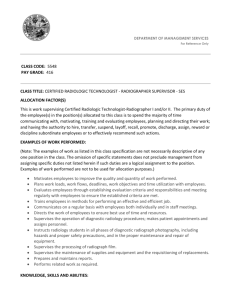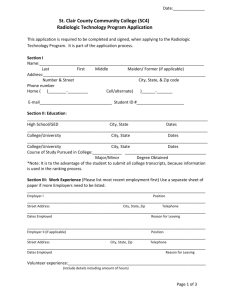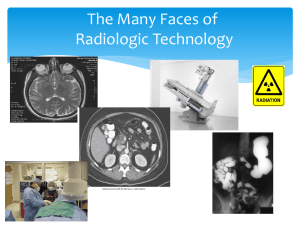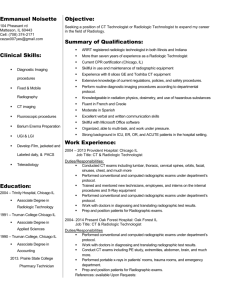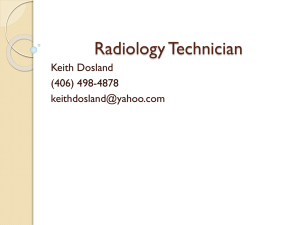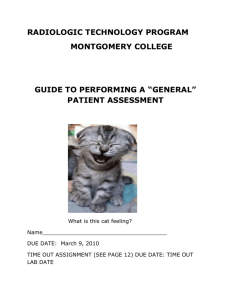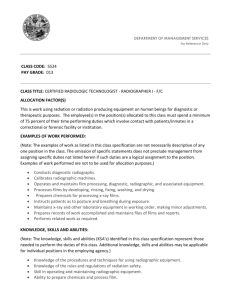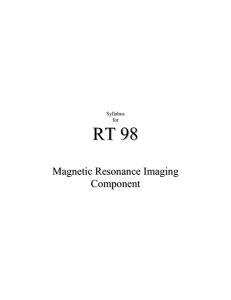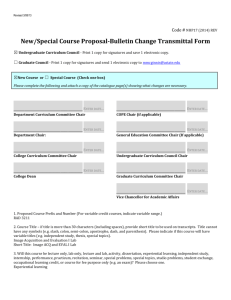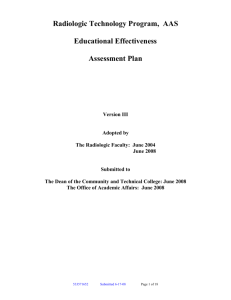HEALTH SCIENCES DIVISION
advertisement
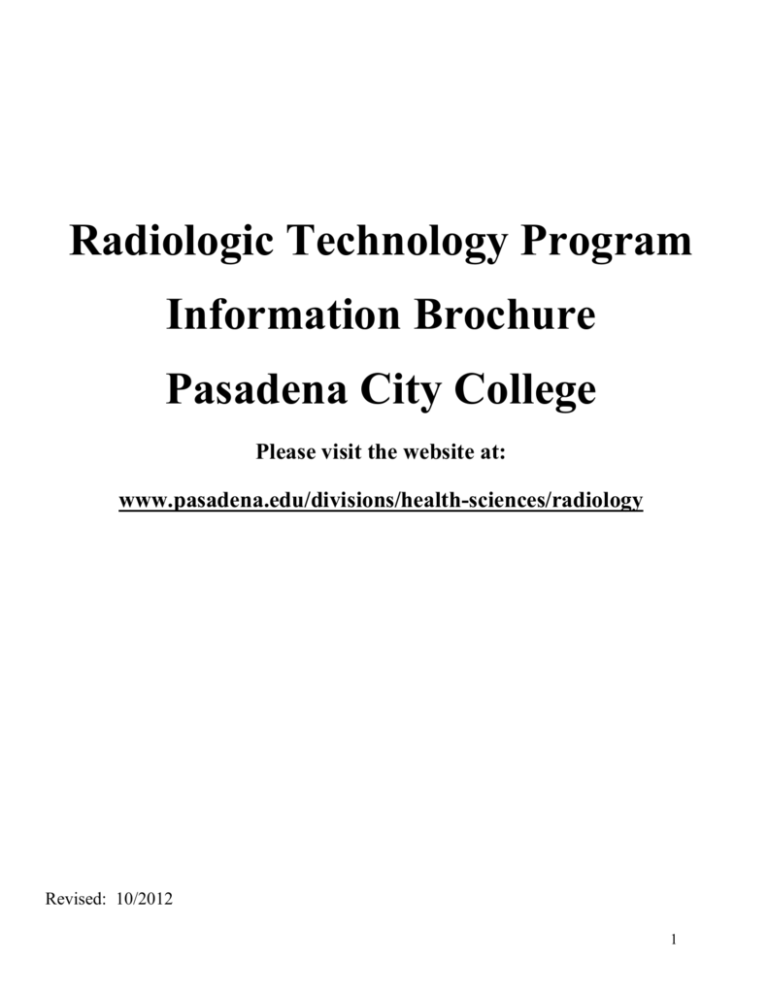
Radiologic Technology Program Information Brochure Pasadena City College Please visit the website at: www.pasadena.edu/divisions/health-sciences/radiology Revised: 10/2012 1 RADIOLOGIC TECHNOLOGY PROGRAM – HEALTH SCIENCES DIVISION The Pasadena City College Radiologic Technology program is accredited by Joint Review Committee on Education in Radiologic Technology (JRCERT). MISSION STATEMENT: The mission of the PCC Radiologic Technology Program is to prepare students for the entrylevel skills required of a Radiologic Technologist by providing high quality instruction with a commitment to multicultural sensitivity by promoting growth of the student as an individual. PROGRAM GOALS: 1. To graduate with the competency and skills required for routine radiographic procedures. 2. Will have cognitive, motor and affective skills that require problem-solving, appropriate communication and critical thinking required of the entry level Radiologic Technologist. 3. To establish and maintain an on-going assessment of skills and knowledge required of a practicing Radiologic Technology professional. Prerequisite Course Requirements 1. Intermediate College Algebra 2. Physics 10 and 10L 3. Chemistry – General, Organic and Biochemistry 4. Physiology 2A & 2B or Anatomy 25 & Physiology 1 5. Medical Terminology (must be a 3 unit course) 6. All Associate Degree general education courses completed “In Progress” work for the prerequisites will not be considered during the selection process. Selection Criteria for Admission All eligible applicants must have a GPA of 2.0 (grade of “C” or better) or higher in the completed prerequisite courses and all general education courses. Selection will be based on a point system (GPA and sixteen volunteer/observation hours). Documented volunteer hours or observation in a Medical Imaging facility (ex. hospital, clinic, doctor’s office, etc.) must be submitted with your application. Eligible applicants will be prioritized as follows: 1. GPA of 2.0 in the completed prerequisite courses, 2.0 in the completed general education courses with an Associate degree, and sixteen volunteer/observation hours. 2. GPA of 2.0 in the completed prerequisite courses and sixteen volunteer/observation hours. If the number of qualified applicants exceeds the number of spaces available, selections will be made by random selection. Alternates will be chosen by random selection. Alternate status does not guarantee selection. The Health Sciences Division will inform applicants of the status of their application by email only. 2 Application Requirements Applicants must submit the following items to the Health Sciences Division CEC B6 which include the following: 1. A Radiologic Technology application signed, dated and completely filled out. 2. Official U.S. High School transcript, or official GED, or a detailed Foreign Equivalency report turned in with the application. Students who have an Associate Degree or higher do not need to submit U.S. High School/GED/Foreign Equivalency report for high school. 3. Official transcript of ALL U. S. colleges and universities attended including Pasadena City College. 4. Documented Volunteer/Observation hours (form will be provided with the application). 5. Minimum age of 18 years, as mandated by the State Health Code, Title 17. 6. A social security number (State of California requirement). The social security number is used for background checks and radiation detection badges. 7. Copy of DD214 if you are a veteran or spouse of a veteran. UNOFFICIAL TRANSCRIPTS AND DIPLOMAS ARE NOT ACCEPTABLE NOTE: If you are not accepted to the program, you must reapply the next year and submit all information again. There is no waiting list and previous applications and transcripts are not kept on file. A completed application packet must be received by the Health Sciences Division between January 3 and February 15. All materials must be received in the Division Office by February 15. Application forms are available online only from January 3 – February 15. Completion and Licensure Upon successful completion of the program students are eligible to take the American Registry of Radiologic Technologist Examination. After successfully passing the American Registry of Radiologic Technologist (ARRT) Examination students are eligible for California licensure. A Certificate of Achievement is awarded upon completion of all required courses with a grade of C or better. Effective January 1, 2015 an applicant must have an Associate or higher degree for eligibility for ARRT certification. Agency Contact Information American Registry of Radiologic Technologists 1255 Northland Drive St. Paul, Minnesota 55120-1155 (651) 687-0048 www.arrt.org Radiologic Health Branch Department of Health Services P. O. Box 997414 Sacramento, CA 95800-7414 (916) 327-5106 http://www.cdph.ca.gov Pasadena City College Radiologic Technology Program Barbara Kissel, Program Director Email: bakissel@pasadena.edu 3 Students with Foreign Transcripts Students with foreign transcripts must have their transcripts evaluated by one of the following three agencies: International Education Academic Credentials American Education Research Research Foundation Evaluation Institute Center (IERF) (ACEI) (AERC) (310) 258 – 9451 (310) 275 – 3530 (626 ) 339 – 4404 (310) 342 - 7086 (310) 275 - 3528 (626) 339 – 9081 www.ierf.org www.acei1.com www.aerc-eval.com Requirements After Acceptance to the Program Students are required to submit evidence of good health documented by a recent physical examination (within the last year) with the required immunizations. The TB test results must be no older than one year and must be done yearly. Students must have and maintain a current American Heart Association CPR/Basic Life Support Card for Health Care Providers while in the program. Students are expected to comply with the program’s clinical uniform standards. Students must provide their own transportation to all on and off campus clinical sites (note that some classes will include evening sessions). Students are required to maintain vehicle liability insurance at all times if using a vehicle to attend clinical or classes. Students are required to obtain a professional liability insurance while in the program. Students enrolled in the Radiologic Technology Program require clinical experience in the curricula (beginning in the summer semester), must be cleared through the process of the criminal background check conducted by CertifiedBackground.com. In the event that a student cannot obtain a background clearance, acceptance to the program will be forfeited. Students who are found to be ineligible for clinical placement by the clinical agency after admission to the program shall be subject to dismissal from the program, as they will be unable to complete mandatory clinical rotations and objectives. Other Information The Radiologic Technology program is a 2-year full time program. The prerequisites take approximately 1-2 years to complete prior to program entrance. It is recommended that students work no more than 15-20 hours per week during the program. Financial aid may be available. Students must apply to the Scholarship and Financial Aid Office. Scholarship opportunities are available. The Radiologic Technology program has established a “Declaration of Pregnancy Policy” that is in compliance with the Nuclear Regulatory Commission regulations. This will be discussed during the RADTC 100/101 courses and reviewed throughout the two years. Students accepted into the program are required to pay college tuition, skills pack, and health fees and any other appropriate fees. The cost of tuition, books, uniforms, insurance, professional membership, markers, and name tags is estimated to be at least $5,000.00 for two years. Non-resident and International students may pay a higher tuition fee. All fees are subject to change. 4 Rules and regulations of the college as well as the program must be adhered to at all times. To enhance student success, students who have English as a second language are encouraged to enroll in Speech 3, Speech 121 and/or Speech 125. The PCC Radiologic Technology program does not accept transfer students from other Radiology programs. Effective January 2015 an Associate’s Degree or higher will be required prior to taking the ARRT exam. Essential Technical Standards It is recommended that Radiologic Technology students meet the following essential technical standards to ensure the safety and welfare of the patients, the health care team and themselves. A physical examination determines whether or not a student meets the technical standards or determines what accommodation may be necessary. The “Technical Standards” have been established as a guidance tool for use in realistically informing the student of minimum standards needed to satisfactorily function in the Program and ultimately in the profession. Capable of standing and/or walking up to seven hours throughout an eight hour shift. Bend, crouch or stoop several times per hour. Lift and carry a minimum of 30 pounds several times an hour. Lift and move up to a 300 lb. patient in a 2-3 person transfer. Reach overhead above the shoulder 90 degrees. Push and/or pull objects and equipment weighing up to 300 pounds. Utilize eyesight to observe patients, manipulate equipment and accessories to evaluate radiographs for technical quality under various illumination levels from low levels of illumination to amber/red lighting to bright light levels. Capable of hearing to effectively communicate with the patient and healthcare team. Utilize sufficient verbal and written skills to effectively and promptly communicate in English with the patient and healthcare team. Manipulate radiologic and medical equipment and accessories, including but not limited to switches, knobs, buttons, keyboards, utilizing fine and gross motor skills. Perform the assigned job responsibilities with the intellectual and emotional functions necessary to ensure patient safety and exercise independent judgment and discretion. Utilize the above standards/functions to respond promptly to the patient’s needs and/or emergency situations. 5 RADIOLOGIC TECHNOLOGY PROGRAM CURRICULUM These required courses must be completed prior to taking the ARRT (licensing exam) as required by the State of California. Summer session Junior level: (6 wks for RADTC 100 and 8 wks for RADTC 101) Department Course # Description Units RADTC 100 Basic Radiologic Technology Practices 2 RADTC 101 Medical Procedures for Radiologic Technology 3 Semester 1 (Fall) Junior level Department Course # Description Units RADTC 102 Radiation Protection 3 RADTC 103A Radiographic Anatomy & Positioning 3 RADTC 110 Ethics 2 RADTC 112A Radiologic Physics 4 RADTC 117A Clinical Experience 2 Semester 2 (Spring) Junior level Department Course # Description Units RADTC 103B Radiographic Anatomy & Positioning 3 RADTC 104 Principles of Radiographic Exposure 3 RADTC 112B Radiographic Physics 3 RADTC 117B Clinical Experience 2 Summer Session 1 Junior level RADTC 113A Clinical Experience 2 RADTC 114 Venipuncture 2 Summer Session 1 Senior level RADTC 113B Clinical Experience Summer session II Senior level Department Course # Description RADTC* 119 Clinical Experience *This course includes 38 hours per week in clinical and a 2-hour evening class. Semester 3 (Fall) Senior level Department Course # Description RADTC* 103C Anatomy & Positioning RADTC 105 Special Radiographic Procedures RADTC 111 Computerized Experience RADTC 117C Clinical Experience Semester 4 (Spring) Senior level Department Course # Description RADTC 116 Perspectives in Radiologic Technology RADTC 118 Fluoroscopy RADTC 117D Clinical Experience Electives (choose one or both) Department Course # Description RADTC 121 Mammography RADTC 123 Computed Tomography 6½ Units 6½ Units 3 3 2 4 Units 2 3 4 Units 3 3 6
